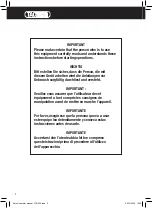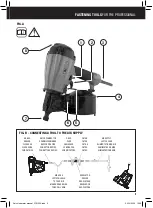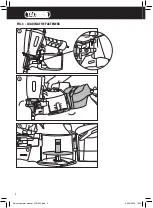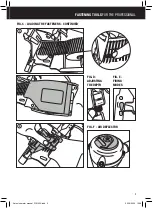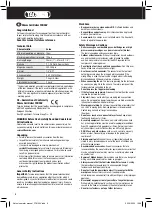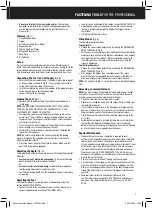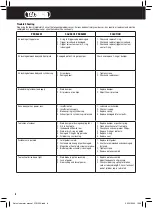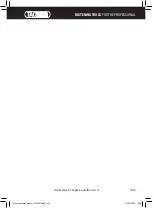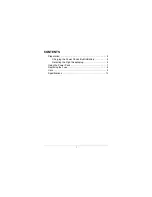
FASTENING TOOLS
FOR THE PROFESSIONAL
7
•
Do not use this tool to fasten electric cables.
This tool is not
designed for the installation of electric cabling and may damage
electric cables which could lead to injury by electric shock or
fire hazards.
Features
(Fig. A)
1. Firing Mode Selector
2. Trigger
3. Quick Release Plug (Euro Fitting)
4. Magazine Drum
5. Depth Adjustment Wheel
6. Magazine Release Latch
7. Nose Piece
8. Air Deflector
Set up
Your air tool is fully assembled when you receive it. Before using it,
attach the air line and desired air system accessories. See Fig. B for the
recommended accessories and connection order. Be sure the air hose
is de-pressurised when installing or removing adaptors to the air line.
Connecting The Tool to an Air Supply
(Fig. B)
• Determine if the tool needs oil and, if necessary, place two drops of
oil in the air plug as shown in Fig. B. If you are using an automatic
in-line oiler, check and add oil if necessary.
• Turn the compressor on and set the regulator to the proper pressure
for the size and type of fastener being used.
• Connect the tool to the air supply.
Loading the Tool
(Fig. C)
• Squeeze latch to open nail door, then rotate magazine door so it
is fully open.
NOTE:
THE MAGAZINE PLATFORM MUST BE SET FOR THE LENGTH
OF NAIL TO BE USED. NAILS WILL NOT FEED SMOOTHLY IF THE
PLATFORM IS NOT CORRECTLY ADJUSTED.
• The magazine contains an adjustable nail platform on which the
nail coil rest. The nail platform can be moved up and down across
various settings. To change nail platform height, screw centre post
until correct height is met.
• Place the coil of nails over the post of the platform in the magazine.
• Uncoil enough nails to reach the nose of the tool.
• Insert the first nail into the nose and the second nail between the
two rails of the feed pawl.
NOTE:
Be careful not to deform the coil of nails during the loading
process. Otherwise, the nail guide door will not close and the nails
might not feed consistently.
• First close magazine cover, then close latch door. Make sure the
door latch is completely engaged.
Adjusting the Depth
(Fig. D)
The driving depth of the fasteners can be set with the depth adjustment
wheel (5).
•
Fasteners are not driven in deep enough:
To increase the driving
depth, turn depth adjustment wheel to the left.
or
•
Fasteners are driven in too deeply:
To reduce the driving depth,
turn the depth adjustment wheel to the right.
•
Test the new driving depth on a test workpiece. Repeat steps above
as required.
Operating the Tool
Test the driving depth in a sample piece of wood before using. See
section ADJUSTING THE DEPTH.
• Connect the tool to the air supply. Make sure the air pressure is in
correct range denoted in section of TECHNICAL DATA.
• Load fasteners as directed in the section called LOADING THE TOOL.
• Hold the body and press the drive guide to work surface, be sure
the tool is straight and then gently depress the trigger to drive
the fastener.
• Lift the tool off the work surface.
Firing Modes
(Fig. E)
The tool has two driving modes:
Sequential fire:
• Choose the correct mode before firing by rotating the FIRING MODE
SELECTOR SWITCH (Fig. E).
• Put the nose on the working surface, lightly push the tool toward the
working surface until the safety bracket is depressed, then, depress
the trigger to drive the fasteners. Whilst maintaining contact with
the working surface, the tool will drive a fastener each time the
trigger is depressed.
Contact trip (Bump fire):
• Choose the correct mode before firing by rotating the FIRING MODE
SELECTOR SWITCH (Fig.E).
• First, depress the trigger, then, repeatedly impact the safety
bracket, the tool can repeatedly drive the fasteners. The tool will
drive one fastener when the safety bracket is impacted once.
NOTE:
The air deflector (Fig. F) is directional and can be rotated through
360°.
Removing a Jammed Fastener
NOTE:
You must remove any jammed fasteners before using the tool
any further. If you continue to try and fire a fastener while the tool is
jammed, you could cause damage to the mechanism.
• Disconnect tool from the compressed air system
• Remove any unused fasteners from the magazine, this should clear
the jammed fastener(s).
• If any fasteners remain stuck in the nose piece, place tool upside
down on a solid surface. Put a punch or small screwdriver into the
firing nozzle and carefully tap to release the jammed fastener.
•
Close the nose plate and lock the latch before reconnecting to the
air system.
• Following the removal of a jammed fastener, always carefully test
the tool function before proceeding with any work. If fasteners
become jammed in the nose piece frequently, have the tool serviced
by a Tacwise Engineer or appointed service agent.
Regular Maintenance
• Frequent, but not excessive, lubrication is required for best
performance. Oil added through the airline connection will lubricate
internal parts. An automatic airline oiler is recommended but oil
may be added manually before every operation or after about 1 hour
of continuous use. Only a few drops of oil at a time are necessary.
Too much oil will collect inside the tool and be blown out during
the exhaust cycle. ONLY USE PNEUMATIC TOOL OIL. Do not use
detergent oil or additives, as these lubricants will cause accelerated
wear to the seal in the tool.
• Use a small amount of oil on all moving surface and pivots.
• Dirt and water in the air supply are major causes of pneumatic tool
wear. Use a filter/oiler for better performance and longer life. The
filter must have adequate flow capacity for the specific application.
Consult the manufacturer’s instructions for proper maintenance of
your filter.
• Keep tools clean for better and safer performance. Use
non-flammable cleaning solutions (CAUTION: Such solutions may
damage O-ring and other tool parts) only if necessary - DO NOT
SOAK.
FASTENING TOOLS
FOR THE PROFESSIONAL
Air tool operator manual_FCN55V.indd 7
Air tool operator manual_FCN55V.indd 7
20/10/2020 15:36
20/10/2020 15:36


